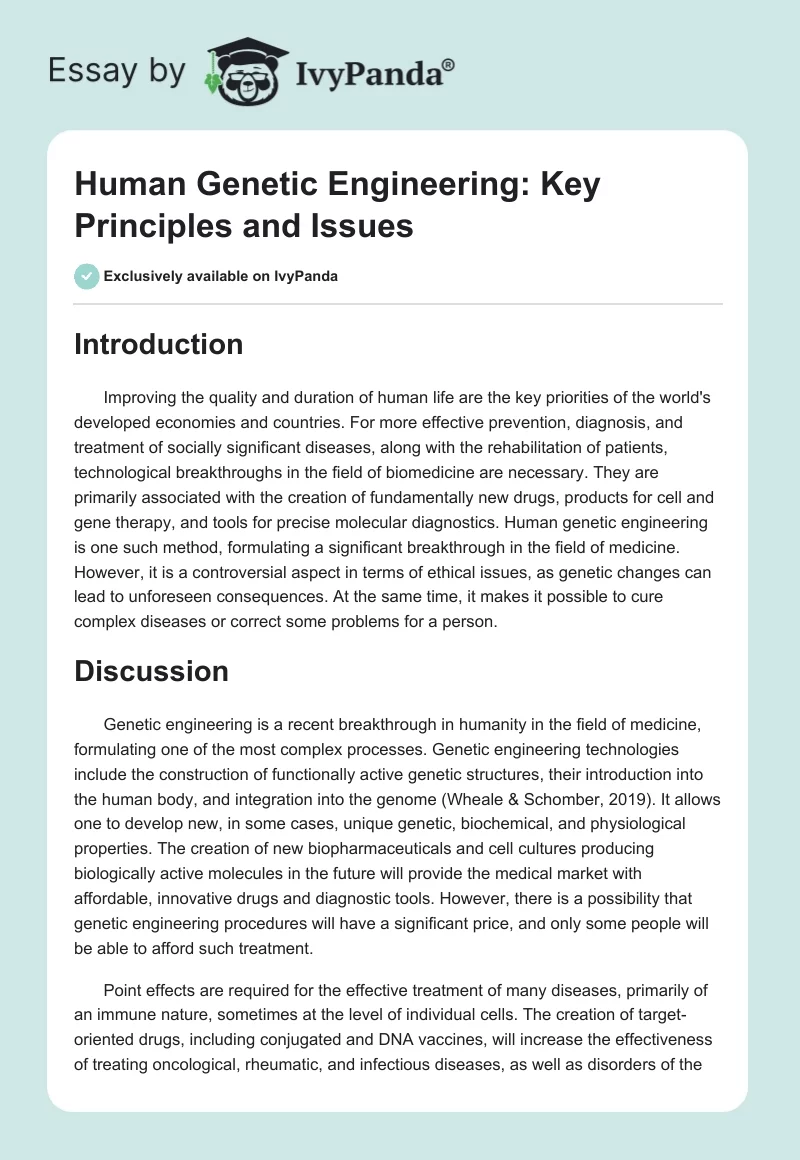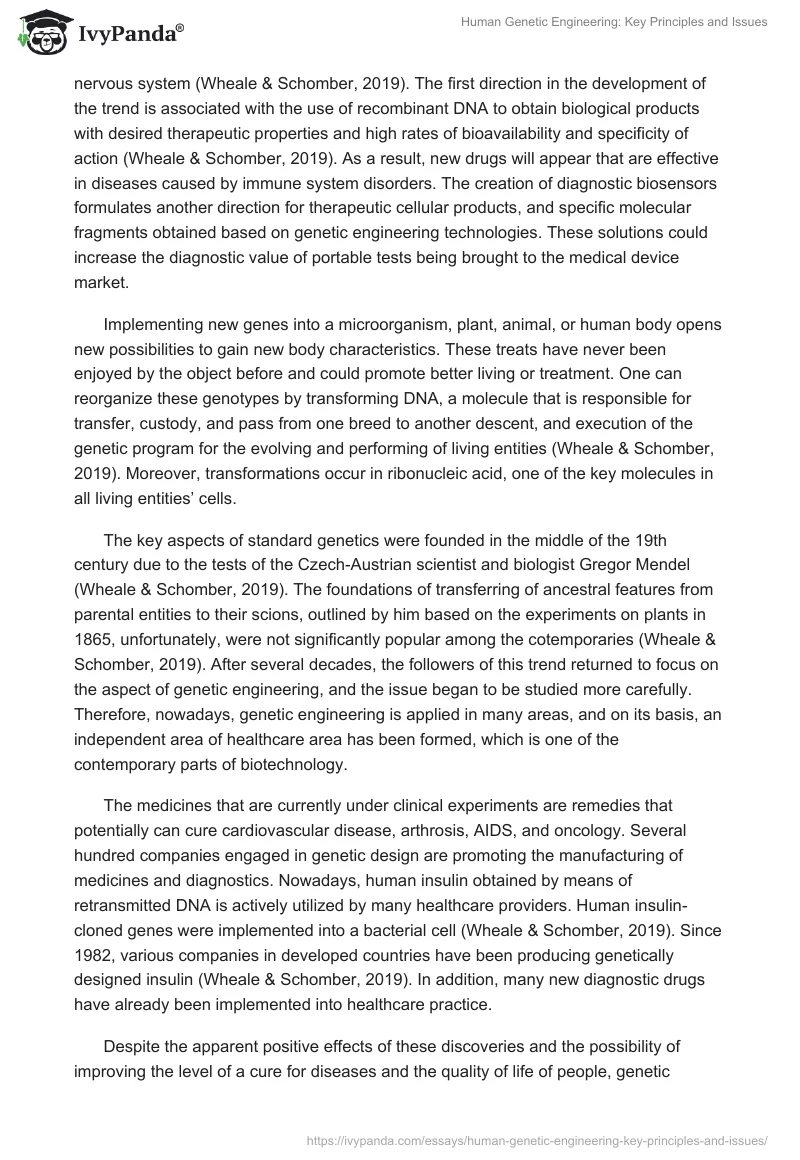Introduction
Improving the quality and duration of human life are the key priorities of the world’s developed economies and countries. For more effective prevention, diagnosis, and treatment of socially significant diseases, along with the rehabilitation of patients, technological breakthroughs in the field of biomedicine are necessary. They are primarily associated with the creation of fundamentally new drugs, products for cell and gene therapy, and tools for precise molecular diagnostics. Human genetic engineering is one such method, formulating a significant breakthrough in the field of medicine. However, it is a controversial aspect in terms of ethical issues, as genetic changes can lead to unforeseen consequences. At the same time, it makes it possible to cure complex diseases or correct some problems for a person.
Discussion
Genetic engineering is a recent breakthrough in humanity in the field of medicine, formulating one of the most complex processes. Genetic engineering technologies include the construction of functionally active genetic structures, their introduction into the human body, and integration into the genome (Wheale & Schomber, 2019). It allows one to develop new, in some cases, unique genetic, biochemical, and physiological properties. The creation of new biopharmaceuticals and cell cultures producing biologically active molecules in the future will provide the medical market with affordable, innovative drugs and diagnostic tools. However, there is a possibility that genetic engineering procedures will have a significant price, and only some people will be able to afford such treatment.
Point effects are required for the effective treatment of many diseases, primarily of an immune nature, sometimes at the level of individual cells. The creation of target-oriented drugs, including conjugated and DNA vaccines, will increase the effectiveness of treating oncological, rheumatic, and infectious diseases, as well as disorders of the nervous system (Wheale & Schomber, 2019). The first direction in the development of the trend is associated with the use of recombinant DNA to obtain biological products with desired therapeutic properties and high rates of bioavailability and specificity of action (Wheale & Schomber, 2019). As a result, new drugs will appear that are effective in diseases caused by immune system disorders. The creation of diagnostic biosensors formulates another direction for therapeutic cellular products, and specific molecular fragments obtained based on genetic engineering technologies. These solutions could increase the diagnostic value of portable tests being brought to the medical device market.
Implementing new genes into a microorganism, plant, animal, or human body opens new possibilities to gain new body characteristics. These treats have never been enjoyed by the object before and could promote better living or treatment. One can reorganize these genotypes by transforming DNA, a molecule that is responsible for transfer, custody, and pass from one breed to another descent, and execution of the genetic program for the evolving and performing of living entities (Wheale & Schomber, 2019). Moreover, transformations occur in ribonucleic acid, one of the key molecules in all living entities’ cells.
The key aspects of standard genetics were founded in the middle of the 19th century due to the tests of the Czech-Austrian scientist and biologist Gregor Mendel (Wheale & Schomber, 2019). The foundations of transferring of ancestral features from parental entities to their scions, outlined by him based on the experiments on plants in 1865, unfortunately, were not significantly popular among the cotemporaries (Wheale & Schomber, 2019). After several decades, the followers of this trend returned to focus on the aspect of genetic engineering, and the issue began to be studied more carefully. Therefore, nowadays, genetic engineering is applied in many areas, and on its basis, an independent area of healthcare area has been formed, which is one of the contemporary parts of biotechnology.
The medicines that are currently under clinical experiments are remedies that potentially can cure cardiovascular disease, arthrosis, AIDS, and oncology. Several hundred companies engaged in genetic design are promoting the manufacturing of medicines and diagnostics. Nowadays, human insulin obtained by means of retransmitted DNA is actively utilized by many healthcare providers. Human insulin-cloned genes were implemented into a bacterial cell (Wheale & Schomber, 2019). Since 1982, various companies in developed countries have been producing genetically designed insulin (Wheale & Schomber, 2019). In addition, many new diagnostic drugs have already been implemented into healthcare practice.
Despite the apparent positive effects of these discoveries and the possibility of improving the level of a cure for diseases and the quality of life of people, genetic engineering has other aspects. Speaking from an ethical point of view, it can have negative consequences as genetic changes can be used for devastating effects. Thus, organizations have introduced various restrictions and moratoriums on experiments, introducing more humane principles. In addition, genetic engineering brings humanity closer to the possibility of cloning, which opens up many options. For example, one could grow a clone for later organ transplantation or use it as a donor. However, whether such a procedure is ethically acceptable remains an open question as opinions differ.
There are many options for the development of events in the field of genetic engineering, and not all of them have been studied. Therefore, they must be consistently fixed and regulated, as bad scenarios of the development of events cause most fears. As a rule, it all starts with helping people and inventing new drugs, and then a person may come to desire to change his child’s hair or eyes or to create an army of universal soldiers who are not afraid of pain and do not know fear. Modern society is so heterogeneous culturally and economically that any methods that can significantly change the genome can create conditions for class and species stratification (Wheale & Schomber, 2019). For example, representatives of the rich world will be able to significantly prolong their lives and not be afraid of any diseases, unlike less wealthy people, and this is a serious ground for conflicts and clashes.
However, many incurable diseases occur due to pathological changes in the cell genome. Traditional drugs are not effective enough in their treatment due to low specificity and, in some cases, significant toxic effects on the body. Moreover, they do not act on the very cause of such diseases, namely somatic mutations of the genome. It is expected that one will be able to target gene expression, interrupting the sequence of pathological changes in the cell (Wheale & Schomber, 2019). In addition, the person will be able to control the critical mechanisms of development, and treatment of oncological diseases will become possible with the help of technologies for the therapeutic use of RNA interference.
Conclusion
To conclude, human genetic engineering is one of the major medical breakthroughs, giving many opportunities for healing and improving life. Genetic engineering is a new direction in the field of molecular biology, which has become widespread in many areas of medicine and biology relatively recently. However, despite the positive effects, it has some controversial ethical aspects. Genetic engineering provides limitless opportunities for humans, including creating their own fearless army, which can be used for crimes. In addition, errors during surgery at the gene level can lead to irreversible negative consequences.
Reference
Wheale, P., & Schomberg, R. (2019). The social management of genetic engineering. Routledge.


